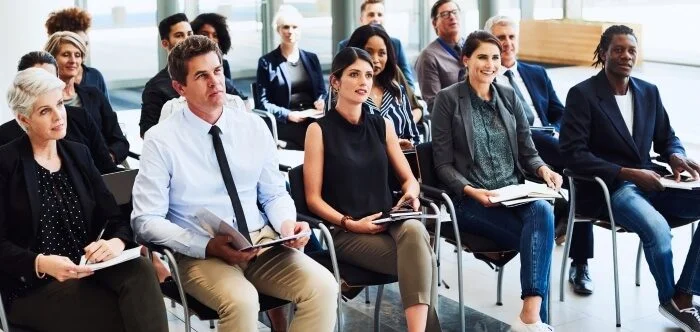A conference’s impact can be measured like a compass, guiding you in the right direction. The value of conferences is best understood when they are carefully analyzed, as they bring together professionals, ideas, and opportunities. So, how do you measure the conference impact?
You can start by collecting feedback from attendees to get insights into their experience and satisfaction. Then, analyze participation levels to see how many participants actively engaged during the conference. Besides that, assessing social media interaction helps understand the conference’s reach and engagement.
Additionally, tracking networking outcomes and measuring the achievement of specific objectives can offer a comprehensive view of the conference’s success. For a deeper dive into each of these metrics, continue reading our detailed article.
What is the Conference’s Purpose?
The purpose of a conference is to bring people together for knowledge sharing, discussions, and networking. It allows professionals and enthusiasts to exchange ideas, learn from experts, and collaborate on future projects. Whether focused on specific industries or broader topics, conferences are designed to create an environment where growth and learning can happen.
At a conference, participants often attend various sessions that delve deep into particular topics. These sessions can be presentations, panel discussions, or workshops that help attendees grasp complex concepts. With the help of industry leaders and seasoned professionals, these events aim to enhance skills and broaden perspectives in the field.

Another core purpose is the opportunity for networking. Conferences bring together people with similar interests and goals, making it easier to form valuable connections. Through casual interactions and formal networking events, attendees can meet potential collaborators, mentors, or even future business partners, which can be crucial for career growth.
When it comes to selecting conferences to attend, understanding the primary goals is essential. Many people consider to attend global events like conferences in Canada for their ability to provide relevant learning experiences and networking opportunities. Each conference is unique, but they all offer a chance to gain new insights and connect with like-minded individuals.
Qualities of a Good Conference
A conference is the cornerstone of professional development, offering a platform for learning, networking, and growth. The success of a conference depends on several key qualities. Identifying these attributes can guide organizers in creating impactful and memorable conferences.
- Engaging Content: A good conference presents relevant and forward-thinking content, sparking interest and discussion among attendees.
- Diverse Speakers: Diversity in speakers brings a range of perspectives, ensuring a rich, inclusive discussion that appeals to a broad audience.
- Effective Organization: Smooth logistics and a well-planned schedule are essential for an uninterrupted experience, maximizing attendee satisfaction and engagement.
- Networking Opportunities: Networking opportunities allow participants to connect, developing collaboration and relationship-building beyond the event.
- Interactive Sessions: Interactive sessions encourage active participation, making the learning experience more engaging and memorable for attendees.
- Accessible Location: An accessible and convenient location maximizes attendance and provides a comfortable environment for attendees.
There is often a lasting impression left by conferences with these qualities. They provide valuable insights and knowledge and create an environment conducive to growth and collaboration. When planning your next event, consider these key aspects to ensure its success.
How Do You Measure the Conference Impact?
Measuring the impact of a conference is essential for understanding its success and areas for improvement. This process involves a series of steps, each focusing on different aspects of the event. Here’s a guide on how do you measure the conference impact on the attendees:
Step-1. Collect Attendee Feedback
Gather feedback through surveys and questionnaires post-event. This allows attendees to express their satisfaction levels, valuable insights, and suggestions for improvement.
Step-2. Analyze Participation Levels
Review registration and attendance records to evaluate the number of participants and their engagement during the conference. This data provides a quantitative measure of the event’s appeal and reach.
Step-3. Assess Social Media Engagement
Examine the conference’s presence on social media platforms. Analyze mentions, shares, and hashtags to gauge public interest and the event’s online visibility.
Step-4. Evaluate Networking Outcomes
Determine the effectiveness of networking sessions by collecting feedback on new connections made and potential collaborations. This aspect reflects the event’s success in building professional relationships.
Step-5. Measure Objective Achievements
Align the conference goals with achieved outcomes. This could include the number of papers presented, deals closed, or partnerships formed, providing a tangible measure of success.
It is important to consider qualitative and quantitative factors when measuring the success of a conference. By systematically evaluating these aspects, conference organizers can assess the current event’s success and set the stage for future conferences that will be even more successful.
Popular Conferences That Are Significantly Impactful
Conferences are crucial in various industries by facilitating knowledge sharing, networking, and innovation. Certain types stand out for their significant impact and global reach. This overview highlights the most influential conferences that have shaped industries and thought leadership.
Technology Conferences
Technology conferences like CES and Web Summit are key in showcasing the latest innovations. They gather tech enthusiasts, entrepreneurs, and investors, Contributing to advancements and collaborations. These events often set the stage for unveiling groundbreaking technologies and future trends.
Academic and Scientific Conferences
Academic conferences, like those hosted by the IEEE and American Psychological Association, are crucial for research dissemination. Scholars present their findings, engage in scholarly debates, and collaborate on future research. These conferences significantly contribute to the progression of scientific knowledge and academic disciplines.
Global Conferences
Many pressing international issues are addressed at global conferences like those organized by the Global Conference Alliance Inc. They bring together world leaders, policymakers, and influential thinkers to discuss global challenges and solutions. These conferences play a key role in shaping international policies and cooperation.
Business and Leadership Conferences
A business conference like the Global Leadership Summit offers a platform for industry leaders to share insights. They provide networking opportunities, develop leadership skills, and discuss market trends and strategies. Such events are instrumental in driving business innovation and leadership development.
Conferences, in their various forms, have a lasting impact on their respective fields. Whether unveiling the latest technology, advancing academic discourse, shaping global policy, or nurturing business leadership, these gatherings are vital in driving progress and innovation. They not only disseminate knowledge but also inspire action and collaboration.
The Benefits a Good Conference Hold for its Attendees
Attending a well-organized conference can offer numerous benefits, enriching its attendees’ professional and personal growth. The advantages are diverse and impactful, from networking opportunities to gaining new knowledge. This detailed breakdown explores the multifaceted benefits that a good conference can provide.
Knowledge Expansion
Conferences are treasure troves of new information, offering insights into the latest trends and research. Attendees gain access to valuable data and case studies, enhancing their industry knowledge. Such events often feature experts discussing the latest developments. This exposure helps attendees stay ahead in their respective fields.
Networking Opportunities
Networking is a key aspect of conferences, connecting professionals from various sectors. Attendees can form new connections, potentially leading to future collaborations or job opportunities. These interactions often result in a valuable exchange of ideas and experiences. Networking at conferences can significantly broaden one’s professional circle.
Skill Development
Workshops and seminars at conferences provide hands-on experience in new skills and technologies. Attendees can learn directly from industry leaders and experts. These sessions offer practical knowledge that can be applied in their careers. Skill enhancement is a key takeaway from such events.
Inspiration and Motivation
Often, conferences inspire attendees through success stories and innovative ideas. A motivational speech from an accomplished speaker can energize attendees to pursue their goals with renewed energy. Such inspiration is a powerful driver of personal and professional growth. By creating memorable conference experiences, organizers can provide an environment that not only educates but also profoundly impacts participants’ ambitions and achievements.
Access to Resources
Attendees gain access to a wealth of resources like toolkits, publications, and software demos. These resources can be invaluable for their professional development and daily tasks. Conferences often provide materials that are otherwise hard to obtain. This access is a significant benefit for attendees.
Industry Trends and Insights
Conferences provide a comprehensive overview of current and emerging industry trends. Understanding these trends is essential for staying competitive and innovative. Attendees can gain foresight into future market directions. This knowledge is crucial for strategic planning in their careers or businesses.
Personal Growth
Conferences offer a unique environment for personal development. Engaging with diverse perspectives broadens one’s worldview. The experience enhances communication and social skills. Personal growth is a natural outcome of participating in these diverse and dynamic environments.
Attending a well-curated conference can be a transformative experience, offering professional and personal benefits. The advantages are substantial and varied, from expanding knowledge and skills to networking and personal growth. These gatherings are not just events but catalysts for long-term development and success.
Tips for Maximizing Conference Attendees
Maximizing attendees’ engagement and satisfaction at conferences can significantly boost the event’s overall success. By implementing strategic approaches, organizers can create a memorable and impactful experience. Here are some essential tips to consider.
- Early Communication: Start by sending detailed information about the conference agenda and speakers to all registered attendees.
- Interactive Sessions: Incorporate interactive sessions that encourage participation and make the experience more engaging for everyone involved.
- Tech Tools: Utilize technology tools for scheduling and feedback to simplify the experience and keep participants informed.
- Diverse Panels: Include diverse panel discussions covering a broad range of topics and perspectives, which contribute to the learning experience.
- Networking Opportunities: Provide networking breaks that are strategically timed and well-organized to maximize interaction among attendees.
- Addressing the Audience: When addressing people at a conference, ensure clarity and purpose to maintain engagement and deliver value.
- Personalized Experiences: Offer personalized agendas that attendees can modify to suit their interests and professional needs.
- Follow-Up Actions: After the event, send out a follow-up email including key takeaways, additional resources, and a feedback survey.
Wrap Up
Measuring the impact of a conference is key to understanding its effectiveness and planning for future improvements. It starts with collecting detailed feedback from attendees and analyzing participation levels to gauge engagement.
When we explore “How do you measure the conference impact?” we find that it involves assessing social media interactions and tracking networking outcomes to judge the conference’s reach and quality. Besides that, organizers can determine the success of a conference by aligning its objectives with its outcomes.
This process not only highlights areas for improvement but also reinforces the value of precise event analysis. By implementing these steps, every conference maximizes its potential for attendees and organizers.







